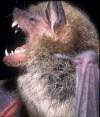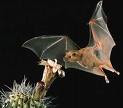Thursday, June 11, 2009
The Healthy Environmental Benefits of Bats
Now as for me, I am not a scientist, teacher or professor. I am just an ordinary person who has done some reading on bats and found them to be very fascinating and not at all what I thought. Because they are not what I expected, I thought I would write a little bit about them and at the same time dispel the rumors and myths associated with the bat.
There are almost a thousand (1000) species of bats with each having its own unique characteristics, features, sizes and foods, much like any other mammal. The bat is the only mammal that is capable of true flight. About 70% of the bats in the world eat insects. Some of the microbats can eat about 300 insects an hour and some can eat about 1000 insects an hour. Think about the advantages of having some bats around when you are having a BBQ and the moths and mosquitoes are out. Better than spraying a bunch of insecticides around that stink and very seldom work for long.
According to some research done by "Bat Conservation International" bat habitats are steadily declining because of man. They are doing active research on man-made bat houses and are having some very good results. One of the results they had from their research was that in central Texas they found that the bats in that area eat approximately two million pounds of insects a night. That is 2,000,000 pounds of insects each night. That is an enormous amount of insects eaten that definitely help the farmers in that area.
Most people are afraid of bats or have an active dislike of them. All the vampire movies around perpetuate this fear also. There are actually only three (3) "vampire bats" around and they are in South America. These bats do not suck the blood out of their victim, that only happens in the movies. Their usual food source are large animals such as horses, cattle or pigs. What they do is slit the skin with their sharp nails or razor sharp teeth and lap up the blood. A bat will drink approximately one ounce of blood a night. Scientist have found that these bats have a blood thinning agent in their saliva and they are studying this agent to be used in treating humans. Another fear that people have is that all bats are carriers of rabies. A study by the University of Florida has shown that less than ½ of 1% of all bats have rabies. It is more likely that a person will be bitten by a dog or cat that is not vaccinated. Now if a bat is found on the ground, common sense tells you to leave it alone. Bats are not normally found on the ground, so it has probably been injured or is sick. Again, leave it alone. Another story that has been heard is that a bat will gets caught in somebody's hair. A bat, using its echolocation can find a little gnat in the air and grab it for food. Because of its ability to "see" with its echolocation it probably would have no problem missing someone's hair. Now the big fruit bats, sometimes called 'flying foxes" and a couple of other bats do not use echolocation. However these are all in the jungles and tropical regions of the world. Anyone in these areas should at least be aware of what is in these places. Another reason for the dislike of bats is that in the olden days bats were thought to be able to communicate with the spirits. This and the fact that bats are night creatures, is why they are used on Halloween and the fact is that some people still believe in the old stories.
Bats help us in many way that most are not even aware of. There are many species that can eat thousands of mosquitoes and crop destroying insects in one evening. Others pollinate many fruits and nuts that we enjoy, such as the vanilla beans, peaches, bananas, avocados, dates, figs, mangoes, cloves, cashews and agave. They also eat the insects that destroy the crops and plants. The guana or bat droppings are some of the richest manures in the world.
Bats account for approximately 25% of the mammals and live on all continents except Antarctica and a few remote islands. Like bears, bats will either migrate to warmer areas or hibernate for the winter. These bats can be helped by man putting up bat houses. They are very picky about their homes. They must roost high enough to avoid predators, the right temperatures to stay warm but not too hot and have food and water nearby.
Monday, May 4, 2009
More About bats
The news media, movies, television, and comic books often perpetuate myths, "old-wives-tales," folklore, legends, and fears about bats that a surprising number of people believe. Bats do not get into your hair, they are not flying mice, they don't come "out of hell," they are not blind, and only three species (not in the U.S. or Canada) make a diet of blood.
Myths about bats are found in many human cultures. The ancient Egyptians believed that bats could prevent or cure poor eyesight, toothache, fever, and baldness, and a bat hung over the doorway of a home was thought to prevent the entry of demons that carried these "diseases." Bat gods were important to many pre-Colombian civilizations in central America, and bats have been used in vodoo worship in parts of Africa as well as in many parts of the Caribbean even today. The association of bats with the legend of human vampires has an uncertain origin, but since the time of Cortez and his Conquistadors, peoples of western civilization have linked vampire bats with the legendary "human" vampires of Transylvania. The writings of William Shakespeare, Robert Louis Stevenson, and others have contributed to legends that cast a veil of fear on people, as they associate bats with graveyards, death, ghosts, and goblins.
To the Chinese, bats are regarded as symbols of happiness and good fortune (health, wealth, serenity, virtue, and long life). At one time Chinese mothers would sew small jade buttons in the shape of a bat on the caps of their babies, a custom believed to impart long life. Ancient and modern-day art objects, tapestries, Imperial robes, home furnishings and the like often include bats as part of the motif.
To the Chinese, bats are regarded as symbols of happiness and good fortune (health, wealth, serenity, virtue, and long life). At one time Chinese mothers would sew small jade buttons in the shape of a bat on the caps of their babies, a custom believed to impart long life. Ancient and modern-day art objects, tapestries, Imperial robes, home furnishings and the like often include bats as part of the motif.
Wednesday, April 1, 2009
Bat Houses for Pest Management
BAT HOUSES FOR INTEGRATED PEST MANAGEMENT BENEFITS FOR BATS AND ORGANIC FARMER
A lot of this information for this article comes from this report by the “Bat Conservation International” of Austin Texas.
Bats are an amazing help to farmers and to folks who want to control the insect problems in their neck of the woods. Bats consume large quantities of insect pests, but many of these bat species are declining due to loss of roost sites. Farmers and other folks can help bats by providing new roosts in the form of bat houses while at the same time benefiting from bats pest reduction services.
Bathouses performed better on the sides of barns or garages rather than on poles. The occupancy rate was much higher on the sides of buildings.
More than half of the 45 species of bats living in the United States and Canada are either endangered or candidates for such status, and many that are considered abundant are declining rapidly. As the bird population was declining because of lack of nesting places, birdhouses of all sorts were used and the population of the declining birds started to rise according to a study by the University of Tennessee.
As was formerly the case with purple martins and bluebirds, roost loss was an important factor in decline. Millions of bats have been forced from caves and old growth forests by human activity. Some have been excluded from buildings and mine closures for safety reasons. Bats are NOT well equipped to handle these threats because they are the worlds slowest reproducing mammals for their size, and they form the largest and most vulnerable aggregations of and vertebrate.
This loss of bat habitats poses a particular problem to agriculture because the bat is the primary predator of vast number of pests that cost American farmers and foresters billions of dollars annually. For example the Mexican free-tail bats from central Texas alone consume approximately two million pounds of insects nightly.
Just as programs for bluebirds, wood ducks and purple martins have provided clear evidence that artificial roosts reverse population declines, so has the Bat House Research Project convincingly demonstrated that artificial roosts also work for bats. Recent studies show that the most common bat house occupants, big brown, little brown and free-tail bats, can be extremely beneficial to agriculture. An organic farmer in Oregon who attracted 600 little brown bats to bat houses reported elimination of a previously serious corn earworm problem. Not only do they consume pests, including corn earworm, armyworm and tobacco budworm moths, but their mere presence can have an effect on insects. It has been documented that moths listen for bat echolocation sounds and avoid areas within 150 feet of were they hear even one bat.
I am really liking the idea of bat houses around to eat the nightly mosquitoes especially as I like to BBQ at night and hate the feel and smell of insect repellents and half the time those don't work anyways.
MORE LATER
KenR
Wednesday, March 25, 2009
Monday, March 23, 2009
BAT FOLLOWUP
Zoologists refer to the bat as a Megachiroptera or Microchiroptera, which just means large bat or small bat. The largest bat has a wingspan of six (6) feet and are fruit bats. The smallest bat has a body length of only one (1) inch. Bats are mammals and the longest known lifespan of a bat in the wild is 30 years for the brown bat.
I am not a scientist, teacher or professor. I am just an ordinary person who has been doing some reading on bats and found them to be quite fascinating. And not at all what I expected. Because they are not what I expected, I thought I would write a little bit about them and maybe dispel some myths while I was at it.
There are almost a thousand (1000) different species of bats. Each has its own unique characteristics, features, sizes and food preferences, much like any other mammal. Bats are the only mammal capable of flight and their skeleton is similar to ours. Approximately 70% of the bats eat flying insects. Some micro-bats can eat up to 300 bugs an hour and some can eat up to 1000 bugs an hour.
Bats homes are being destroyed on a continual basis and personally I would rather have some bats around than use use insecticides around where I am living and eating.
Most people are afraid of bats or have an active dislike of them, mostly because they don't understand them or what they do for us. All the vampire movies around contribute to this illogical fear. Actually the “blood sucking vampire bats” are only in the movies. There are three “blood drinking “bats (vampire bats) and they are all in South America. They usually feed on cattle and other small animals. They slit the skin and lap up the blood. Scientists are just finding out that they use a blood thinning agent in their saliva, and are studying the effects of this agent to treat humans that require blood thinning drugs.
The other thing that people are afraid of is the myth that all bats have rabies. A study at the University of Florida has shown that less than ½ of 1% of all bats have rabies. It is more likely for a person to be bitten by an unvaccinated dog or cat.
We have all heard stories about bats getting stuck in a persons hair. A bat can find a tiny gnat with its echolocation abilities, they definitely can get around us. Common sense says that if you find a bat on the ground, leave it alone. Bats are not normally on the ground, so they could be injured or sick. Like all mammals, bats can carry rabies, so leave alone if on the ground.
Another reason why people don't like bats is because in the olden days bats were thought to communicate or talk with the spirits. This and the fact that they are night creatures, is why they are used on Halloween and some people still believe in the old stories.
Bats help people in several ways. There are many species that can eat thousands of mosquitoes and crop destroying insects in a single night. Others pollinate many fruits and nuts that we enjoy, such as vanilla beans, peaches, banana's, avocados, dates, figs, mangoes, cloves, cashews and agave. They also eat the insects that destroy crops and plants.
Bats account for approximately 25% of all mammals on this earth and live on all continents except Antarctica and a few islands. Like bears, bats will either migrate to warmer climes in the winter or hibernate. We can help these bats which are so beneficial by putting up bat houses. They are very picky about their homes. They must roost high enough to avoid predators, the right temperatures to stay warm but not to hot and have food and water nearby.
KenR
Sunday, March 22, 2009
BATS
Zoologist's refer to bats as “chiroptera”, this is the order of mammal that they belong in. I am not a scientist or a teacher or a professor. I am just an normal person and have been doing some reading on bats and found them to be quite interesting and serve a very useful purpose. So I thought I would write a little bit about them and maybe dispel some myths at the same time.
There are almost a thousand(1000) different types of bats. Each has its own unique characteristics, features, sizes and food, much like any other mammal. Bats are the only mammal capable of true flight and their skeleton is similar to ours. Their wings are anatomically like our hands with extremely elongated fingers. As per the picture above, you can see why the order is called “chiroptera” which means “hand-wing”.
Some fruit bats have a wingspan of six(6) feet and others are as small as a bumblebee. Some live on fruit and nectars and others eat only flying insects. Approximately 70% of all bats eat flying insects. Some micro-bats eat up to 300 bugs an hour and some can eat a thousand mosquitoes in an hour. So the next time that you have a barbecue , think about how much help a bat would be if there were lots of mosquitoes around, especially if your cooking at night and the sprays and chemicals just don't work or they stink so bad that who wants to use them. Because most bats normal homes are being destroyed on a continual basis, it may be necessary to put up some bat homes. I'll cover these in a later blog.
KenR




